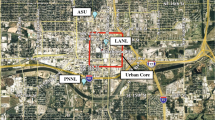Abstract
Using a high resolution meteorology-chemistry transport model, simulations were performed to estimate the sensitivity of the model results to nesting. The model results are compared with airplane measurements made during the TRACT field measuring campaign in September, 1992. For the meteorological part of the model the performance is enhanced using one-way nesting in a larger scale model, if the quality of the large scale driving data is sufficient. The sensitivity of the NOx concentration results with respect to nesting of chemical quantities is rather low due to the poor quality of the forcing data. A correct description of the emission rates and the meteorological conditions may be more important. For ozone, the best results can be achieved with either no nesting or a meteorological and chemical nested model simulation, which is again a result of the poor quality of the forcing data.
Similar content being viewed by others
References
Ebel, A., Elbern, H., Feldmann, H., Jakobs, H. J., Kessler, C., Memmesheimer, M., Oberreuter, A. and Piekorz, G.: 1997, Air Pollution Studies with the EURAD Model System (3): EURAD-European Air Pollution Dispersion Model System, Mitteilungen aus dem Institut für Geophysik und Meteorologie der Universität zu Köln, Heft 120.
Grell, A. G., Dudhia, J. and Stauffer, D. R.: 1993, A Description of the Fifth-Generation PENN STATE/NCAR MESOSCALE MODEL (MM5), NCAR Technical Note 398+IA. National Center for Atmospheric Research, Boulder, Colorado, USA.
Hass, H.: 1991, Description of the EURAD Chemistry-Transport-Model Version 2 (CTM2), Mitteilungen aus dem Institut für Geophysik und Meteorologie der Universität zu Köln, Heft 83.
Müller, F., Schlünzen, K. H. und Schatzmann, M.: 2000, Test of numerical solvers for chemical reaction mechanisms in 3D-air quality models, in print by Environmental Modelling and Software.
Niemeier, U.: 1997, Chemische Umsetzungen in einem hochauflösenden mesoskaligen Modell-Bestimmung geeigneter Randwerte und Modellanwendungen, Berichte aus dem Zentrum für Meeres-und Klimaforschung, Reihe A, 28. Zentrum für Meeres-und Klimaforschung der Universität Hamburg, Meteorologisches Institut.
Schlünzen, K. H.: 1990, Numerical Studies on the Inland Penetration of Sea Breeze Fronts at a Coastline with Tidally Flooded Mudflats, Beitr. Phys. Atmosph., 63, 243–256.
Schlünzen, K. H., Bigalke, K., Lenz, C.-J., Lüpkes, C., Niemeier, U. and von Salzen, K.: 1996, Concept and Realization of the Mesoscale Transport and Fluid Model 'METRAS', METRAS Technical Report, 5, Meteorological Institute, University of Hamburg, Bundesstr. 55, D-20146 Hamburg, Germany.
Schlünzen, K. H., Schaller, E., Ebel, A.: 2000, An evaluation strategy for mesoscale atmospheric chemistry transport models, in preparation for Atmos. Environ.
Stockwell, W. R., Middelton, P. and Chang, J. S.: 1990, The Second Generation Regional Acid Deposition Model Chemical Mechanism for Regional Air Quality Modeling, J. Geophys. Res., 85, D10, 16343–16367.
Zimmermann, H.: 1995, Field Phase Report of the TRACT Field Measurement Campaign, EUROTRAC International Scientific Secretary, Garmisch-Partenkirchen, Germany.
Author information
Authors and Affiliations
Rights and permissions
About this article
Cite this article
Lenz, CJ., Müller, F. & Schlünzen, K.H. The Sensitivity of Mesoscale Chemistry Transport Model Results to Boundary Values. Environ Monit Assess 65, 287–295 (2000). https://doi.org/10.1023/A:1006467431546
Issue Date:
DOI: https://doi.org/10.1023/A:1006467431546




